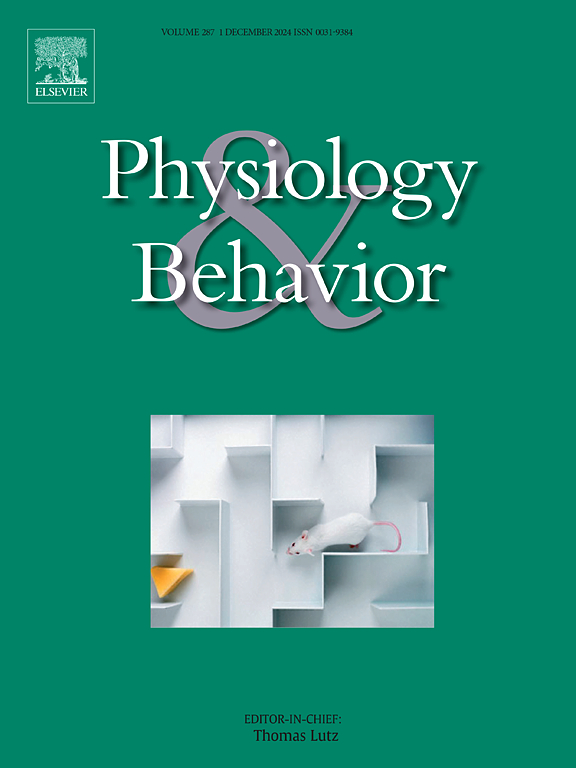二氧化碳反应性和食欲素活性与对恐惧和奖励线索的灭绝记忆的关联:来自大量雄性大鼠的多项研究结果。
IF 2.5
3区 医学
Q2 BEHAVIORAL SCIENCES
引用次数: 0
摘要
巴甫洛夫条件反射可以用来模拟焦虑/创伤和物质使用障碍中出现的适应不良关联。减弱条件反射的一种方法是消退学习(这是暴露疗法的基础),在这种方法中,线索被反复呈现,而没有预期的恐惧或奖励结果。灭绝并不是对所有人都有效;因此,确定能够对无应答者进行表型分析的生物标志物对于优化治疗是必要的。食欲素系统与恐惧和奖励消退以及对二氧化碳暴露的反应有关。我们之前发现,二氧化碳反应性预测恐惧消退记忆和二氧化碳诱导的食欲素活性,而食欲素活性与消退记忆有关。在另一项研究中,我们重复了二氧化碳反应性预测恐惧消退记忆的发现,并将这一发现扩展到食欲消退记忆。在这里,我们结合了来自这三项研究的雄性大鼠的行为和食欲素活动数据,以检验我们是否可以在更大的组合样本中发现恐惧和奖励消失与二氧化碳反应性和食欲素之间的新的或常见的联系。我们发现,在恐惧和食欲相结合的样本中,二氧化碳反应性和二氧化碳诱导的食欲素活性都与灭绝记忆无关。我们在联合恐惧样本中发现了常见的二氧化碳反应性预测因子,包括一个与食欲素活性相关的新预测因子。在扩展分析中,我们发现先前的CO2暴露可能影响随后的CO2反应性并降低食欲素活性。我们的研究结果支持二氧化碳反应性作为一种筛选工具的潜力,用于识别暴露治疗的可能应答者,尽管特定的预测因子可能因强化物价而异。本文章由计算机程序翻译,如有差异,请以英文原文为准。
Associations of CO2 reactivity and orexin activity with extinction memory to fear and reward cues: results from a large sample of male rats across multiple studies
Pavlovian conditioning can be used to model maladaptive associations seen in anxiety/trauma and substance use disorders. One approach to attenuate conditioned responses is extinction learning (which underlies exposure therapy), wherein cues are repeatedly presented without the expected fearful or rewarding outcome. Extinction is not effective for all; therefore, identifying biomarkers that can phenotype non-responders is necessary to optimize treatment. The orexin system is involved in fear and reward extinction and responses to CO2 exposure. We previously found that CO2 reactivity predicts fear extinction memory and CO2-induced orexin activity, and orexin activity is associated with extinction memory. In a separate study, we replicated the finding that CO2 reactivity predicts fear extinction memory and extended this finding to appetitive extinction memory. Here, we combined behavioral and orexin activity data from these three studies in male rats to examine whether we might identify new or common associations of fear and reward extinction with CO2 reactivity and orexin in a larger combined sample. We found that neither CO2 reactivity nor CO2-induced orexin activity associate with extinction memory in the combined fear and appetitive sample. We found common CO2 reactivity predictors in the combined fear sample, including a new predictor associated with orexin activity. In an expanded analysis, we found that prior CO2 exposure may affect subsequent CO2 reactivity and decrease orexin activity. Our findings support the potential of CO2 reactivity to serve as a screening tool for identifying likely responders to exposure-based therapy, though specific predictors may differ by reinforcer valence.
求助全文
通过发布文献求助,成功后即可免费获取论文全文。
去求助
来源期刊

Physiology & Behavior
医学-行为科学
CiteScore
5.70
自引率
3.40%
发文量
274
审稿时长
47 days
期刊介绍:
Physiology & Behavior is aimed at the causal physiological mechanisms of behavior and its modulation by environmental factors. The journal invites original reports in the broad area of behavioral and cognitive neuroscience, in which at least one variable is physiological and the primary emphasis and theoretical context are behavioral. The range of subjects includes behavioral neuroendocrinology, psychoneuroimmunology, learning and memory, ingestion, social behavior, and studies related to the mechanisms of psychopathology. Contemporary reviews and theoretical articles are welcomed and the Editors invite such proposals from interested authors.
 求助内容:
求助内容: 应助结果提醒方式:
应助结果提醒方式:


